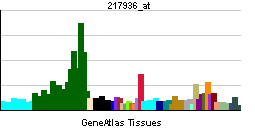ARHGAP5
| Rho GTPase activating protein 5 | |||||||||||
|---|---|---|---|---|---|---|---|---|---|---|---|
| Identifiers | |||||||||||
| Symbols | ARHGAP5 ; RhoGAP5; p190-B | ||||||||||
| External IDs | Template:OMIM5 Template:MGI HomoloGene: 907 | ||||||||||
| |||||||||||
| RNA expression pattern | |||||||||||
 | |||||||||||
| More reference expression data | |||||||||||
| Orthologs | |||||||||||
| Template:GNF Ortholog box | |||||||||||
| Species | Human | Mouse | |||||||||
| Entrez | n/a | n/a | |||||||||
| Ensembl | n/a | n/a | |||||||||
| UniProt | n/a | n/a | |||||||||
| RefSeq (mRNA) | n/a | n/a | |||||||||
| RefSeq (protein) | n/a | n/a | |||||||||
| Location (UCSC) | n/a | n/a | |||||||||
| PubMed search | n/a | n/a | |||||||||
Rho GTPase activating protein 5, also known as ARHGAP5, is a human gene.[1]
Rho GTPase activating protein 5 negatively regulates RHO GTPases, a family which may mediate cytoskeleton changes by stimulating the hydrolysis of bound GTP. Two transcript variants encoding different isoforms have been found for this gene.[1]
References
Further reading
- Ellis C, Moran M, McCormick F, Pawson T (1990). "Phosphorylation of GAP and GAP-associated proteins by transforming and mitogenic tyrosine kinases". Nature. 343 (6256): 377–81. doi:10.1038/343377a0. PMID 1689011.
- Foster R, Hu KQ, Shaywitz DA, Settleman J (1994). "p190 RhoGAP, the major RasGAP-associated protein, binds GTP directly". Mol. Cell. Biol. 14 (11): 7173–81. PMID 7935432.
- McGlade J, Brunkhorst B, Anderson D; et al. (1993). "The N-terminal region of GAP regulates cytoskeletal structure and cell adhesion". EMBO J. 12 (8): 3073–81. PMID 8344248.
- Burbelo PD, Miyamoto S, Utani A; et al. (1996). "p190-B, a new member of the Rho GAP family, and Rho are induced to cluster after integrin cross-linking". J. Biol. Chem. 270 (52): 30919–26. PMID 8537347.
- Bonaldo MF, Lennon G, Soares MB (1997). "Normalization and subtraction: two approaches to facilitate gene discovery". Genome Res. 6 (9): 791–806. PMID 8889548.
- Zrihan-Licht S, Fu Y, Settleman J; et al. (2000). "RAFTK/Pyk2 tyrosine kinase mediates the association of p190 RhoGAP with RasGAP and is involved in breast cancer cell invasion". Oncogene. 19 (10): 1318–28. doi:10.1038/sj.onc.1203422. PMID 10713673.
- Kulkarni SV, Gish G, van der Geer P; et al. (2000). "Role of p120 Ras-GAP in directed cell movement". J. Cell Biol. 149 (2): 457–70. PMID 10769036.
- Chakravarty G, Roy D, Gonzales M; et al. (2000). "P190-B, a Rho-GTPase-activating protein, is differentially expressed in terminal end buds and breast cancer". Cell Growth Differ. 11 (7): 343–54. PMID 10939588.
- Strausberg RL, Feingold EA, Grouse LH; et al. (2003). "Generation and initial analysis of more than 15,000 full-length human and mouse cDNA sequences". Proc. Natl. Acad. Sci. U.S.A. 99 (26): 16899–903. doi:10.1073/pnas.242603899. PMID 12477932.
- Shiota M, Tanihiro T, Nakagawa Y; et al. (2004). "Protein tyrosine phosphatase PTP20 induces actin cytoskeleton reorganization by dephosphorylating p190 RhoGAP in rat ovarian granulosa cells stimulated with follicle-stimulating hormone". Mol. Endocrinol. 17 (4): 534–49. doi:10.1210/me.2002-0187. PMID 12554790.
- Wennerberg K, Forget MA, Ellerbroek SM; et al. (2004). "Rnd proteins function as RhoA antagonists by activating p190 RhoGAP". Curr. Biol. 13 (13): 1106–15. PMID 12842009.
- Su L, Agati JM, Parsons SJ (2004). "p190RhoGAP is cell cycle regulated and affects cytokinesis". J. Cell Biol. 163 (3): 571–82. doi:10.1083/jcb.200308007. PMID 14610059.
- Ota T, Suzuki Y, Nishikawa T; et al. (2004). "Complete sequencing and characterization of 21,243 full-length human cDNAs". Nat. Genet. 36 (1): 40–5. doi:10.1038/ng1285. PMID 14702039.
- Colland F, Jacq X, Trouplin V; et al. (2004). "Functional proteomics mapping of a human signaling pathway". Genome Res. 14 (7): 1324–32. doi:10.1101/gr.2334104. PMID 15231748.
- Blanchetot C, Chagnon M, Dubé N; et al. (2005). "Substrate-trapping techniques in the identification of cellular PTP targets". Methods. 35 (1): 44–53. doi:10.1016/j.ymeth.2004.07.007. PMID 15588985.
- Vargo-Gogola T, Heckman BM, Gunther EJ; et al. (2006). "P190-B Rho GTPase-activating protein overexpression disrupts ductal morphogenesis and induces hyperplastic lesions in the developing mammary gland". Mol. Endocrinol. 20 (6): 1391–405. doi:10.1210/me.2005-0426. PMID 16469769.
- Zhan X, Desiderio DM (2006). "Nitroproteins from a human pituitary adenoma tissue discovered with a nitrotyrosine affinity column and tandem mass spectrometry". Anal. Biochem. 354 (2): 279–89. doi:10.1016/j.ab.2006.05.024. PMID 16777052.
| This protein-related article is a stub. You can help Wikipedia by expanding it. |